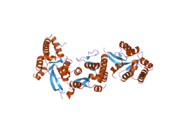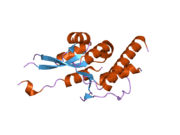SMG6
Telomerase-binding protein EST1A is an enzyme that in humans is encoded by the SMG6 gene on chromosome 17.[5][6][7] It is ubiquitously expressed in many tissues and cell types.[8] The C-terminus of the EST1A protein contains a PilT N-terminus (PIN) domain. This structure for this domain has been determined by X-ray crystallography.[9] SMG6 functions to bind single-stranded DNA in telomere maintenance and single-stranded RNA in nonsense-mediated mRNA decay (NMD).[10][11] The SMG6 gene also contains one of 27 SNPs associated with increased risk of coronary artery disease.[12]
Structure
Gene
The SMG6 gene resides on chromosome 17 at the band 17p13.3 and contains 30 exons.[13] This gene produces 3 isoforms through alternative splicing.[14]
Protein
SMG6 is one of three human homologs for Est1p found in Saccharomyces cerevisiae. It contains a PIN domain, which is characteristic of proteins with ribonuclease activity.[15] The PIN domain forms an alpha/beta fold structure that similar to that found in 5' nucleases.[16] Within the PIN domain is a canonical triad of acidic residues that functions to cleave single-stranded RNA.[17] SMG6 also shares a phosphoserine-binding domain resembling the one in 14–3–3 proteins with its other two homologs, SMG5 and SMG7. This 14–3–3-like domain and a C-terminal helical hairpins domain with seven α-helices stacked perpendicular to the 14–3–3-like domain together form a monomeric tetratricopeptide region (TPR). Differences in the orientation and specific residues in the TPR between SMG6 and its homologs may account for why SMG6 does not form a complex with SMG5 and SMG7 when recruited by UPF1.[18]
Function
SMG6 is broadly expressed in all human tissues. It has dual functions in telomere maintenance and RNA surveillance pathways. SMG6 binds single-stranded telomere DNA and cooperates with telomerase reverse transcriptase to lengthen telomeres.[6] Overexpression of SMG6 induces anaphase bridges due to chromosome-end fusions and, thus, affects telomere capping, which may directly induce an apoptotic response.[19][5] SMG6 also functions as an endonuclease in the NMD pathway. The catalytic activity of SMG6 resides in its PIN domain, which is required for the degradation of premature translation termination codons (PTC)-containing mRNAs in human cells.[20] SMG6 cleaves mRNA near the premature translocation-termination codons and requires UPF1 and SMG1 to reduce reporter mRNA levels.[21]
Clinical significance
In humans, selected genomic regions based on 150 SNPs were identified in a genome-wide association study (GWAS) on coronary artery disease. Accordingly, the association between recent smoking and the CpG sites within and near these coronary artery disease-related genes were investigated in 724 Caucasian subjects from the Rotterdam Study. The identified methylation sites were found in SMG6 together with other genes, and several of these sites exhibited lower methylation in subjects currently smoking compared to never smoking.[22]
Clinical marker
A multi-locus genetic risk score study based on a combination of 27 loci, including the SMG6 gene, identified individuals at increased risk for both incident and recurrent coronary artery disease events, as well as an enhanced clinical benefit from statin therapy. The study was based on a community cohort study (the Malmo Diet and Cancer study) and four additional randomized controlled trials of primary prevention cohorts (JUPITER and ASCOT) and secondary prevention cohorts (CARE and PROVE IT-TIMI 22).[12]
References
- GRCh38: Ensembl release 89: ENSG00000070366 - Ensembl, May 2017
- GRCm38: Ensembl release 89: ENSMUSG00000038290 - Ensembl, May 2017
- "Human PubMed Reference:". National Center for Biotechnology Information, U.S. National Library of Medicine.
- "Mouse PubMed Reference:". National Center for Biotechnology Information, U.S. National Library of Medicine.
- Reichenbach P, Höss M, Azzalin CM, Nabholz M, Bucher P, Lingner J (April 2003). "A human homolog of yeast Est1 associates with telomerase and uncaps chromosome ends when overexpressed". Current Biology. 13 (7): 568–74. doi:10.1016/S0960-9822(03)00173-8. PMID 12676087.
- Snow BE, Erdmann N, Cruickshank J, Goldman H, Gill RM, Robinson MO, Harrington L (April 2003). "Functional conservation of the telomerase protein Est1p in humans". Current Biology. 13 (8): 698–704. doi:10.1016/S0960-9822(03)00210-0. PMID 12699629.
- "Entrez Gene: SMG6 Smg-6 homolog, nonsense mediated mRNA decay factor (C. elegans)".
- "BioGPS - your Gene Portal System". biogps.org. Retrieved 2016-10-12.
- Takeshita D, Zenno S, Lee WC, Saigo K, Tanokura M (July 2006). "Crystallization and preliminary X-ray analysis of the PIN domain of human EST1A". Acta Crystallographica Section F. 62 (Pt 7): 656–8. doi:10.1107/S1744309106020057. PMC 2242961. PMID 16820686.
- Snow BE, Erdmann N, Cruickshank J, Goldman H, Gill RM, Robinson MO, Harrington L (April 2003). "Functional conservation of the telomerase protein Est1p in humans". Current Biology. 13 (8): 698–704. doi:10.1016/s0960-9822(03)00210-0. PMID 12699629.
- Huntzinger E, Kashima I, Fauser M, Saulière J, Izaurralde E (December 2008). "SMG6 is the catalytic endonuclease that cleaves mRNAs containing nonsense codons in metazoan". RNA. 14 (12): 2609–17. doi:10.1261/rna.1386208. PMC 2590965. PMID 18974281.
- Mega JL, Stitziel NO, Smith JG, Chasman DI, Caulfield MJ, Devlin JJ, Nordio F, Hyde CL, Cannon CP, Sacks FM, Poulter NR, Sever PS, Ridker PM, Braunwald E, Melander O, Kathiresan S, Sabatine MS (June 2015). "Genetic risk, coronary heart disease events, and the clinical benefit of statin therapy: an analysis of primary and secondary prevention trials". Lancet. 385 (9984): 2264–71. doi:10.1016/S0140-6736(14)61730-X. PMC 4608367. PMID 25748612.
- "SMG6 SMG6, nonsense mediated mRNA decay factor [Homo sapiens (human)] - Gene - NCBI". www.ncbi.nlm.nih.gov. Retrieved 2016-10-12.
- "SMG6 - Telomerase-binding protein EST1A - Homo sapiens (Human) - SMG6 gene & protein". www.uniprot.org. Retrieved 2016-10-12.
- Glavan F, Behm-Ansmant I, Izaurralde E, Conti E (November 2006). "Structures of the PIN domains of SMG6 and SMG5 reveal a nuclease within the mRNA surveillance complex". The EMBO Journal. 25 (21): 5117–25. doi:10.1038/sj.emboj.7601377. PMC 1630413. PMID 17053788.
- Takeshita D, Zenno S, Lee WC, Saigo K, Tanokura M (September 2007). "Crystal structure of the PIN domain of human telomerase-associated protein EST1A". Proteins. 68 (4): 980–9. doi:10.1002/prot.21351. PMID 17557331.
- Huntzinger E, Kashima I, Fauser M, Saulière J, Izaurralde E (December 2008). "SMG6 is the catalytic endonuclease that cleaves mRNAs containing nonsense codons in metazoan". RNA. 14 (12): 2609–17. doi:10.1261/rna.1386208. PMC 2590965. PMID 18974281.
- Chakrabarti S, Bonneau F, Schüssler S, Eppinger E, Conti E (August 2014). "Phospho-dependent and phospho-independent interactions of the helicase UPF1 with the NMD factors SMG5-SMG7 and SMG6". Nucleic Acids Research. 42 (14): 9447–60. doi:10.1093/nar/gku578. PMC 4132714. PMID 25013172.
- Karlseder J, Broccoli D, Dai Y, Hardy S, de Lange T (February 1999). "p53- and ATM-dependent apoptosis induced by telomeres lacking TRF2". Science. 283 (5406): 1321–5. doi:10.1126/science.283.5406.1321. PMID 10037601.
- Huntzinger E, Kashima I, Fauser M, Saulière J, Izaurralde E (December 2008). "SMG6 is the catalytic endonuclease that cleaves mRNAs containing nonsense codons in metazoan". RNA. 14 (12): 2609–17. doi:10.1261/rna.1386208. PMC 2590965. PMID 18974281.
- Nicholson P, Josi C, Kurosawa H, Yamashita A, Mühlemann O (August 2014). "A novel phosphorylation-independent interaction between SMG6 and UPF1 is essential for human NMD". Nucleic Acids Research. 42 (14): 9217–35. doi:10.1093/nar/gku645. PMC 4132754. PMID 25053839.
- Steenaard RV, Ligthart S, Stolk L, Peters MJ, van Meurs JB, Uitterlinden AG, Hofman A, Franco OH, Dehghan A (2015-01-01). "Tobacco smoking is associated with methylation of genes related to coronary artery disease". Clinical Epigenetics. 7: 54. doi:10.1186/s13148-015-0088-y. PMC 4443552. PMID 26015811.
Further reading
- Nakajima D, Okazaki N, Yamakawa H, Kikuno R, Ohara O, Nagase T (June 2002). "Construction of expression-ready cDNA clones for KIAA genes: manual curation of 330 KIAA cDNA clones". DNA Research. 9 (3): 99–106. CiteSeerX 10.1.1.500.923. doi:10.1093/dnares/9.3.99. PMID 12168954.
- Nagase T, Ishikawa K, Suyama M, Kikuno R, Miyajima N, Tanaka A, Kotani H, Nomura N, Ohara O (October 1998). "Prediction of the coding sequences of unidentified human genes. XI. The complete sequences of 100 new cDNA clones from brain which code for large proteins in vitro". DNA Research. 5 (5): 277–86. doi:10.1093/dnares/5.5.277. PMID 9872452.
- Hoff C, Seranski P, Mollenhauer J, Korn B, Detzel T, Reinhardt R, Ramser J, Poustka A (November 2000). "Physical and transcriptional mapping of the 17p13.3 region that is frequently deleted in human cancer". Genomics. 70 (1): 26–33. doi:10.1006/geno.2000.6353. PMID 11087658.
- Chiu SY, Serin G, Ohara O, Maquat LE (January 2003). "Characterization of human Smg5/7a: a protein with similarities to Caenorhabditis elegans SMG5 and SMG7 that functions in the dephosphorylation of Upf1". RNA. 9 (1): 77–87. doi:10.1261/rna.2137903. PMC 1370372. PMID 12554878.
- Ohnishi T, Yamashita A, Kashima I, Schell T, Anders KR, Grimson A, Hachiya T, Hentze MW, Anderson P, Ohno S (November 2003). "Phosphorylation of hUPF1 induces formation of mRNA surveillance complexes containing hSMG-5 and hSMG-7". Molecular Cell. 12 (5): 1187–200. doi:10.1016/S1097-2765(03)00443-X. PMID 14636577.
- Fukuhara N, Ebert J, Unterholzner L, Lindner D, Izaurralde E, Conti E (February 2005). "SMG7 is a 14-3-3-like adaptor in the nonsense-mediated mRNA decay pathway". Molecular Cell. 17 (4): 537–47. doi:10.1016/j.molcel.2005.01.010. PMID 15721257.
- Azzalin CM, Lingner J (February 2006). "The human RNA surveillance factor UPF1 is required for S phase progression and genome stability". Current Biology. 16 (4): 433–9. doi:10.1016/j.cub.2006.01.018. PMID 16488880.
- Takeshita D, Zenno S, Lee WC, Saigo K, Tanokura M (July 2006). "Crystallization and preliminary X-ray analysis of the PIN domain of human EST1A". Acta Crystallographica Section F. 62 (Pt 7): 656–8. doi:10.1107/S1744309106020057. PMC 2242961. PMID 16820686.
- Glavan F, Behm-Ansmant I, Izaurralde E, Conti E (November 2006). "Structures of the PIN domains of SMG6 and SMG5 reveal a nuclease within the mRNA surveillance complex". The EMBO Journal. 25 (21): 5117–25. doi:10.1038/sj.emboj.7601377. PMC 1630413. PMID 17053788.
- Takeshita D, Zenno S, Lee WC, Saigo K, Tanokura M (September 2007). "Crystal structure of the PIN domain of human telomerase-associated protein EST1A". Proteins. 68 (4): 980–9. doi:10.1002/prot.21351. PMID 17557331.








